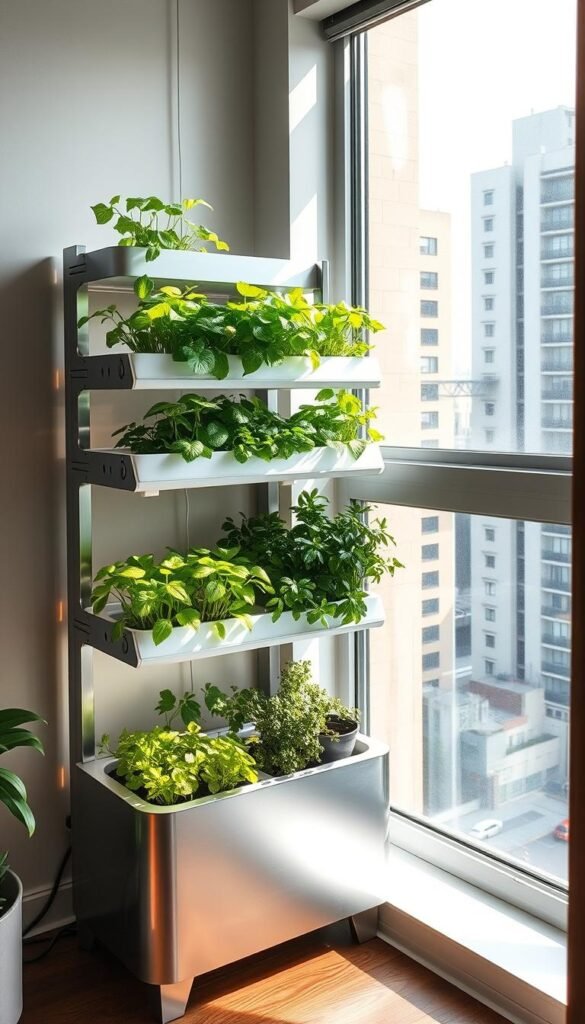Imagine growing fresh herbs and crisp lettuce without backyard space or garden soil. This isn’t science fiction – it’s modern plant cultivation through water-based growing methods. By replacing dirt with carefully balanced liquid nutrition, you can turn windowsills or balcony corners into thriving green zones.
City dwellers across America are discovering how vertical setups and space-saving designs make agriculture possible in studio apartments. These methods use 90% less water than traditional farming while yielding faster harvests. From Brooklyn fire escapes to Chicago high-rises, innovative growers are proving that square footage doesn’t limit fresh food production.
Getting started requires just a few basic components: a container, growth medium, and specially formulated plant food. Many hydroponic gardening for beginners setups cost less than a weekly grocery bill. Popular starter options like the Kratky method let plants drink at their own pace without pumps or electricity.
This guide will walk you through choosing the right configuration for your living situation, from countertop herb gardens to wall-mounted strawberry towers. We’ll explore lighting tricks for shadowy corners and share which crops thrive in controlled environments. Ready to transform unused nooks into salad factories?
Understanding Hydroponics in Urban Settings
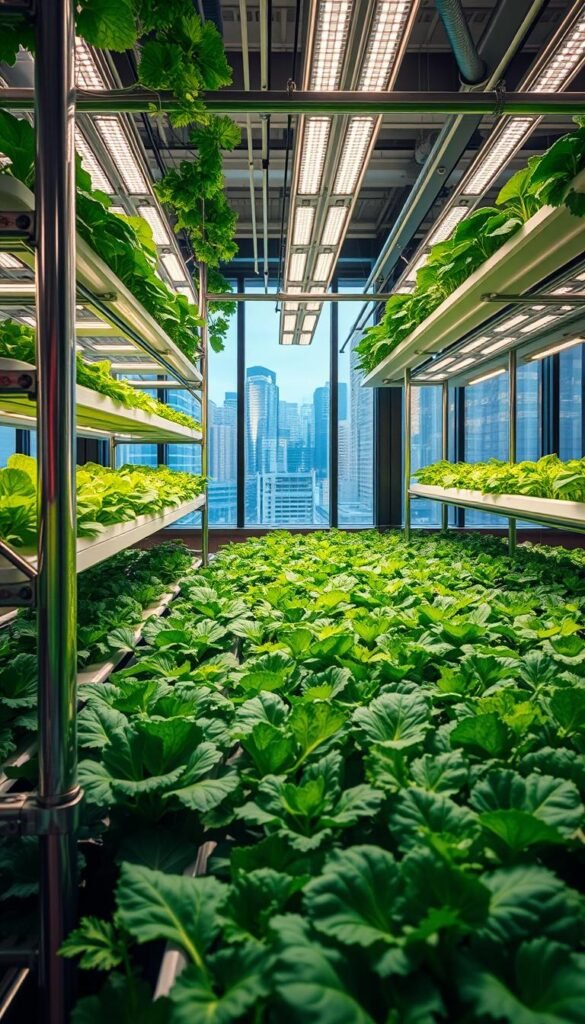
Urban living doesn’t have to mean giving up fresh greens – hydroponics turns cramped quarters into productive gardens. This method skips soil entirely, using water nutrient solutions to deliver exactly what plants crave. Unlike traditional gardening, roots absorb minerals directly from liquid, speeding up plant growth by 30-50% in many cases.
Defining Hydroponics and Its Fundamentals
At its core, a hydroponic system relies on three essentials: oxygenated water, balanced nutrients, and proper light exposure. You control every variable – no guessing about soil quality or weather changes. Roots thrive in clay pellets or rockwool instead of dirt, accessing food through carefully measured solutions.
Water management is key. Too little flow causes stagnation, while excessive movement stresses plants. Many urban growers start with small-scale hydroponic systems that self-regulate moisture levels. These setups prevent overwatering, a common issue in container gardening.
Exploring Urban Constraints and Opportunities
Apartment dwellers face unique challenges: limited square footage, poor natural light, and strict lease agreements. But here’s where hydroponics shines. Vertical towers let you grow 20 plants in 2 square feet. Full-spectrum grow lights compensate for dark corners, mimicking sunlight for herbs like basil and mint.
Creative solutions abound. Convert a bookshelf into a layered lettuce farm. Use balcony railings for strawberry vines. Even narrow windowsills become micro-gardens with compact systems. By optimizing vertical space and artificial lighting, you’ll harvest crisp greens year-round – no backyard required.
Benefits of Intro to Hydroponics in Tiny Urban Spaces
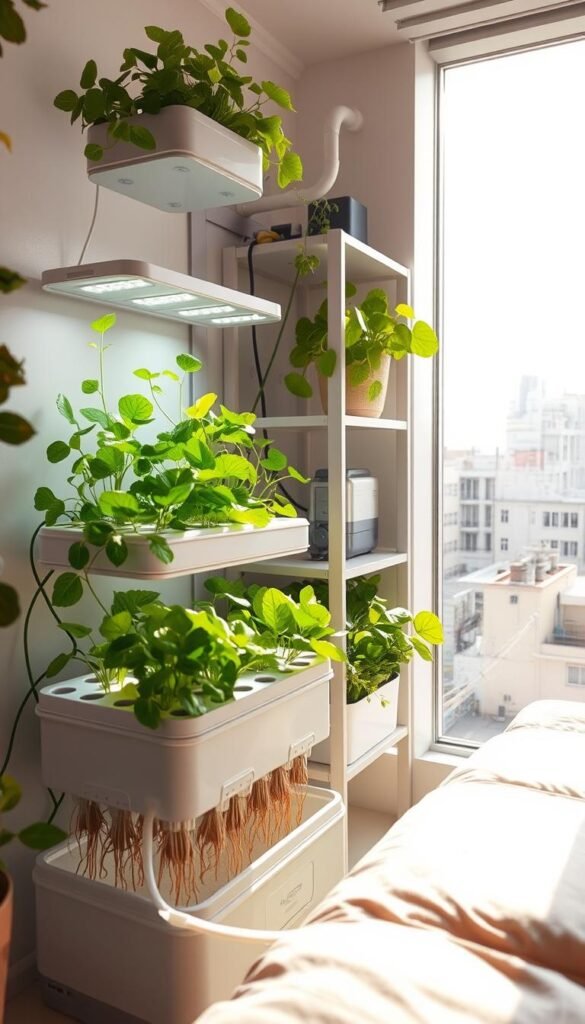
Compact hydroponic systems unlock surprising advantages for city residents. These setups let you grow leafy greens and herbs where traditional pots wouldn’t fit – think above kitchen counters or under shelves. You’ll use 90% less water than soil gardening while getting harvests twice as fast.
Smart Solutions for Tight Quarters
Vertical towers and wall-mounted planters turn blank walls into food factories. A 3-foot tower can hold 18 plants – perfect for basil, kale, or strawberries. Nutrient-rich water solutions feed roots directly, skipping soil’s guesswork. This controlled approach prevents wasted resources and boosts growth rates by up to 50%.
| Feature | Traditional Gardening | Hydroponic Setup |
|---|---|---|
| Water Use | 10 gallons/week | 1 gallon/week |
| Space Needed | 10 sq ft | 2 sq ft |
| Growth Speed | 6-8 weeks (lettuce) | 3-4 weeks |
| Year-Round Yield | Seasonal | Continuous |
Automated systems take the work out of plant care. Timers manage lighting and nutrient delivery, ensuring perfect conditions 24/7. If issues arise, our guide to troubleshooting common issues keeps your garden thriving.
You’ll enjoy fresh salads even in winter – no backyard required. These methods slash water bills while cutting grocery trips. It’s farming reinvented for apartment life.
Choosing Your Hydroponic System for Small Spaces
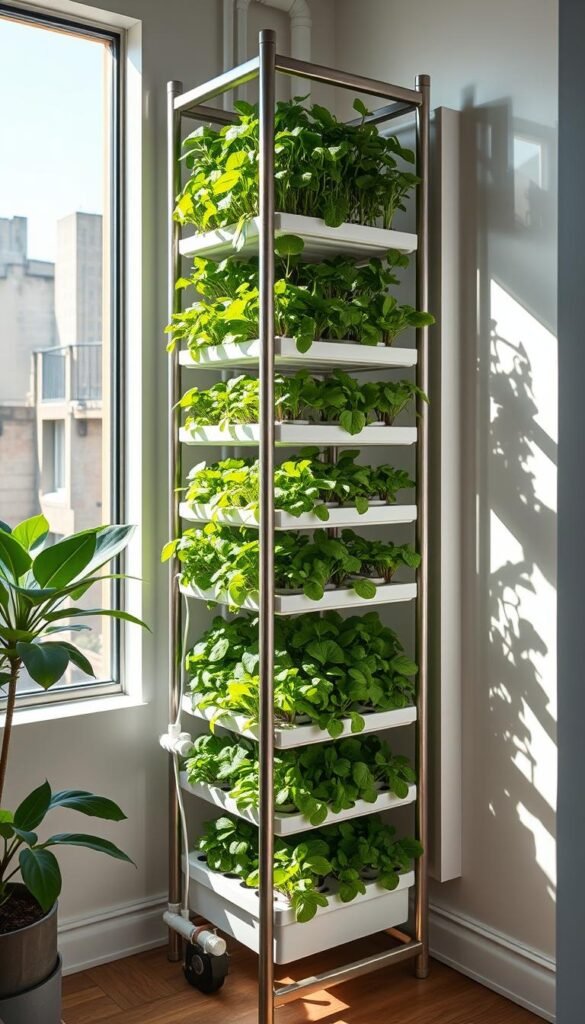
Picking the right setup transforms cramped areas into lush gardens. Three hydroponic systems dominate urban spaces: deep water culture, nutrient film technique, and vertical designs. Each option balances space efficiency with plant needs – your challenge is matching them to your environment.
Deep Water Culture and Nutrient Film Techniques
DWC systems float plant roots in oxygen-rich water full of nutrients. They’re beginner-friendly and quiet – no pumps needed. But they require weekly water checks and work best for leafy greens like spinach.
NFT setups use shallow streams of nutrient solution flowing through sloped channels. These conserve water and suit herbs like cilantro. However, power outages can dry roots quickly in these recirculating systems.
Hydroponic Wall and Vertical System Options
Wall-mounted planters turn blank surfaces into edible art. Stackable towers grow 20 space plants in 3 square feet – ideal for strawberries or cherry tomatoes. Many models include built-in LED lights for shadowy corners.
| System Type | Space Needed | Best For | Maintenance |
|---|---|---|---|
| Deep Water Culture | 2 sq ft | Leafy greens | Weekly checks |
| Nutrient Film | 4 sq ft | Herbs | Daily monitoring |
| Vertical Tower | 1.5 sq ft | Fruiting plants | Biweekly cleaning |
Selecting a System That Fits Your Urban Environment
Measure your available space before choosing. Balconies suit compact NFT channels, while studio apartments benefit from vertical towers. For fresh greens year-round, consider self-watering wall systems near windows.
Start small – a $50 DWC kit grows 6 plants. Upgrade later as you master nutrient balancing. Remember: successful hydroponics relies more on consistent care than expensive gear.
Optimizing Lighting and Nutrient Solutions for Your Indoor Garden
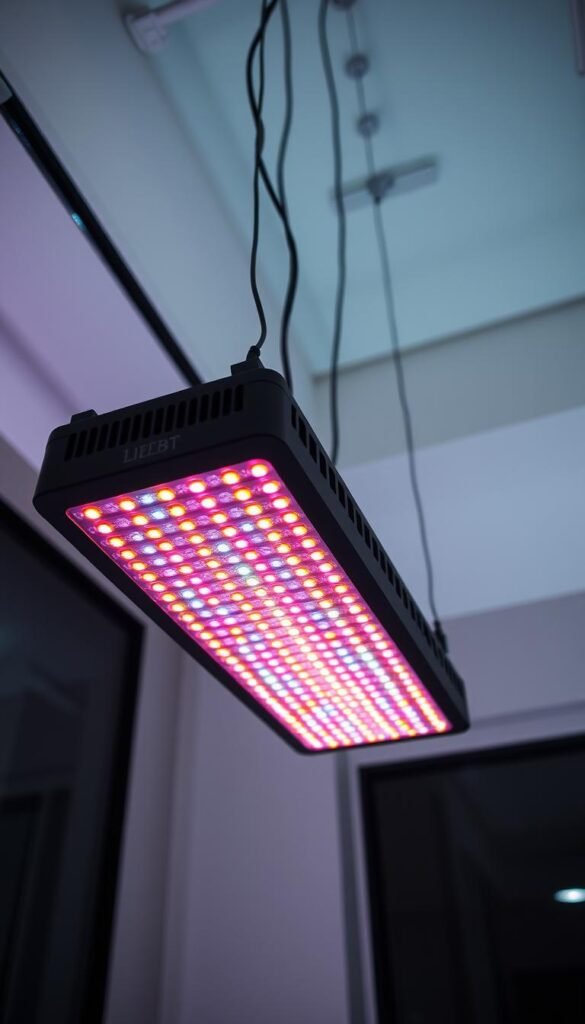
Your plants’ success hinges on two critical elements: precise lighting and balanced nutrition. Urban growers often underestimate how these factors work together to boost yields. Let’s explore how to maximize both without wasting energy or space.
Selecting the Ideal Grow Lights
Not all lights work equally for water-based gardens. LEDs lead the pack with 50% energy savings compared to older options. Full-spectrum models mimic sunlight, supporting herbs from seedling to harvest. Fluorescent tubes offer budget-friendly alternatives for small leafy greens.
| Light Type | Energy Use | Best For | Lifespan |
|---|---|---|---|
| LED | Low | All growth stages | 50,000 hours |
| Fluorescent | Medium | Seedlings/leafy greens | 10,000 hours |
| HID | High | Large fruiting plants | 5,000 hours |
Position lights 6-12 inches above plants for optimal photosynthesis. Use timers to provide 14-16 hours daily for most greens. Rotate plants weekly for even exposure.
Balancing Water Nutrients, pH, and Energy Efficiency
Nutrient solutions need regular tweaking. Test pH weekly – 5.5-6.5 is ideal for most crops. Hydroponic-specific formulas prevent salt buildup that harms roots. Pair with efficient lighting to reduce overall energy use by up to 40%.
Consider these maintenance tips:
- Change solutions every 2-3 weeks
- Use pH-up/down solutions sparingly
- Install reflective surfaces to amplify light
When lights and nutrients work in harmony, you’ll see faster growth and higher yields. Start with simple setups, then expand as you master these essential elements.
Selecting Plants and Designing Your Urban Hydroponic Setup
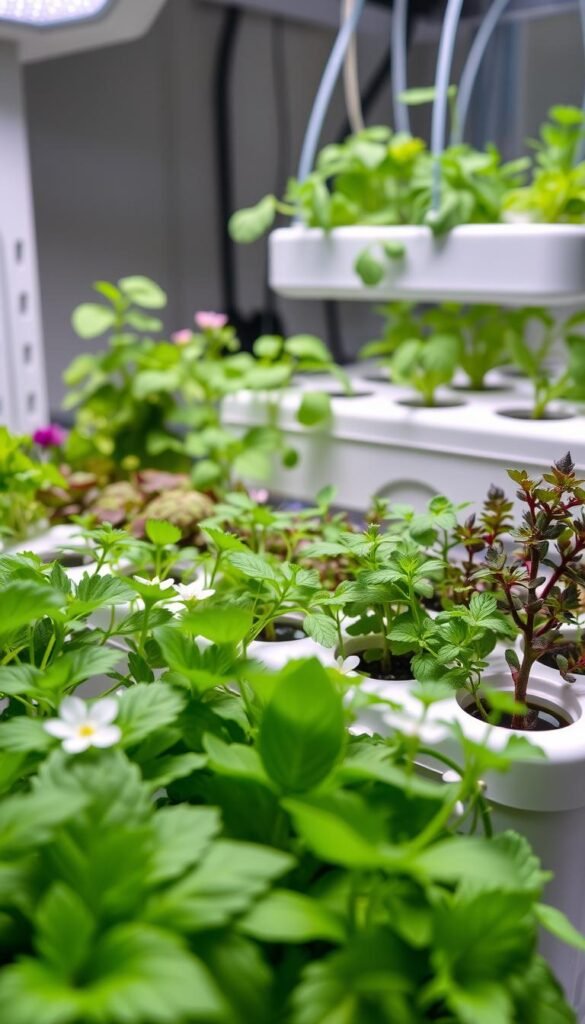
Transform your apartment into a lush oasis by pairing smart plant choices with sleek hydroponic designs. Successful growers match crop varieties to their system’s capabilities – not every species thrives in water-based environments. Focus on fast-growing plants that reward limited spaces with abundant harvests.
Tailoring Crops to Your Setup
Begin with low-maintenance herbs like basil and mint – these adapt well to most systems and provide quick results. Leafy greens such as kale and arugula flourish under consistent full-spectrum lighting, maturing in 3-4 weeks. For vertical towers, try compact strawberries or cherry tomatoes that climb rather than spread.
Consider these growth factors:
- Root depth compatibility with your system
- Daily light requirements (12-16 hours for fruiting plants)
- Nutrient solution strength for different growth stages
Blending Beauty With Productivity
Turn functional gardens into decor statements using color-coordinated planters and strategic lighting. Mount clear acrylic channels on blank walls to create living art with purple basil and rainbow chard. Use tiered shelves to showcase trailing plants like oregano beside upright lettuce varieties.
Space-saving design hacks:
- Rotate modular plant pods weekly for even light exposure
- Install mirrored backsplashes to amplify brightness
- Use neutral-toned reservoirs that complement room aesthetics
By mixing textures and heights, you’ll create visual interest while maximizing yield. Remember: healthy plant growth starts with choosing varieties suited to your specific conditions. Start with 2-3 compatible species, then expand as you master their needs.
Overcoming Challenges and Enhancing System Efficiency
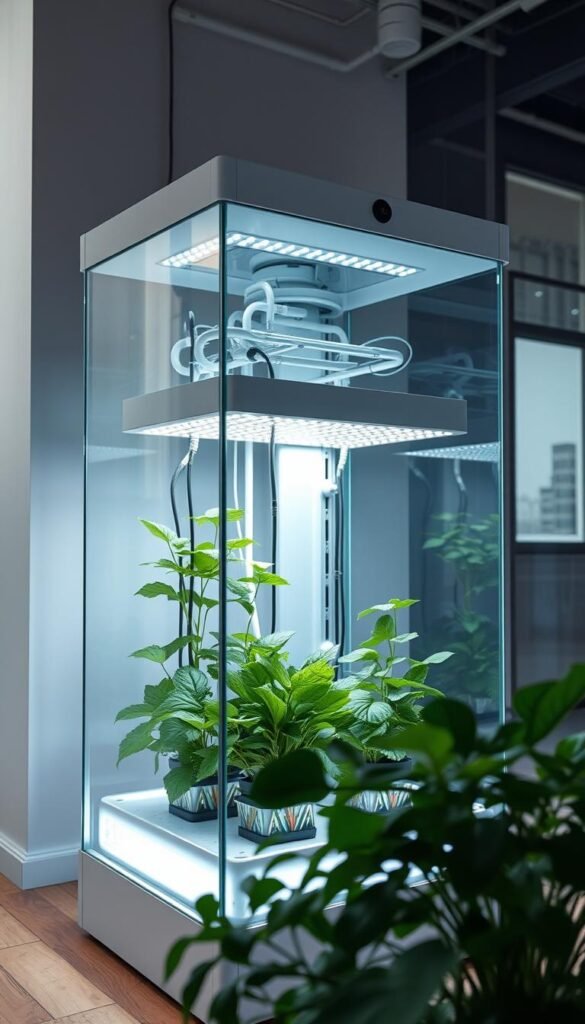
Even the most efficient gardens face hiccups – but smart strategies keep your plants thriving. Balancing maintenance with system performance becomes crucial when working in tight areas. Let’s tackle common obstacles and reveal clever fixes that maximize yields.
Maintenance, Troubleshooting, and Cost Considerations
Weekly checks prevent 80% of hydroponic issues. Test nutrient solution strength and pH levels every 5-7 days. Cloudy water? You might need to flush the system and refresh the mix. Power outages demand quick action – battery backups keep pumps running during blackouts.
| Challenge | Low-Cost Fix | Long-Term Solution |
|---|---|---|
| Algae Growth | Cover reservoirs | Install UV sterilizer |
| Root Rot | Increase air stones | Automated oxygen sensors |
| pH Fluctuations | Manual testing kits | Digital monitoring system |
Recirculating systems cut water use by 40% compared to drain-to-waste setups. Start with affordable materials like food-grade buckets before investing in commercial gear. Group plants with similar needs to simplify care.
Innovative Approaches to Boost Performance in Limited Spaces
Double your growing area without expanding footprints. Stackable planters with built-in air circulation let roots breathe in cramped quarters. Try these space-smart upgrades:
- Clip-on LED bars adjust light spectrum for seedlings
- Magnetic mounting panels for wall systems
- Self-cleaning filters in nutrient-rich water
Vertical aeroponic towers mist roots directly, using 60% less water than traditional methods. Pair them with Wi-Fi sensors that alert you to temperature shifts or low solution levels. Remember: healthy plants start with proactive care – not just quick fixes.
Wrapping Up Your Hydroponic Journey in Urban Environments
Your compact hydroponic system proves that concrete jungles can’t stifle green ambitions. Through smart design and light spectrum management, you’ll grow herbs and fruiting plants where others see empty walls. These setups slash water use by 90% while delivering harvests 3x faster than soil gardens – a game-changer for city dwellers.
Success starts with matching your space to the right setup. Vertical towers excel for strawberries, while countertop kits nurture basil effortlessly. As this hydroponics 101 guide explains, controlled environments eliminate weather worries and boost growth efficiency year-round.
Ready to get started? Begin with a simple deep water culture kit – perfect for lettuce and mint. Monitor pH weekly and adjust lighting durations as plants mature. Automated timers and reflective surfaces maximize energy savings without sacrificing yields.
Every windowsill or balcony corner holds potential. With the right resources and attention to nutrient balance, your urban oasis will flourish. Your first crisp, homegrown bite awaits – why wait another season?

